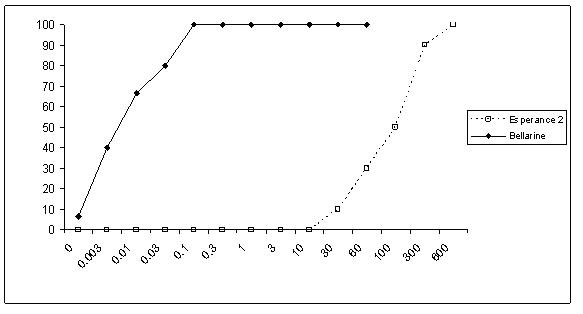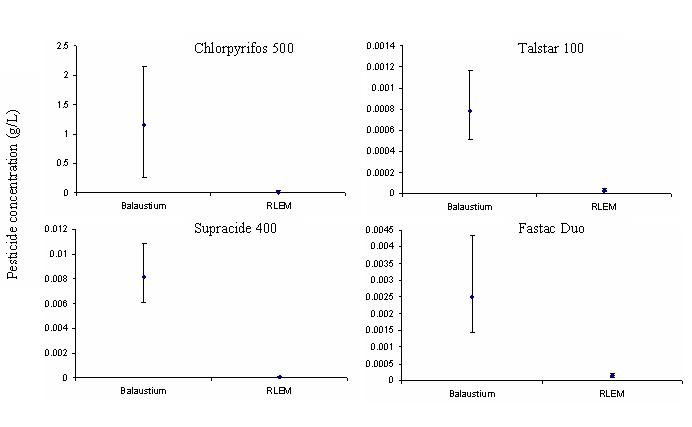Cropping Insects
| Date: 18 Jun 2008

Cropping Insects
Why we need to be smarter and who is on your side
Ken Henry and Judy Bellati, SARDI Entomology
Take home messages
• Chemical resistance of pests is emerging as a genuine threat to the grains industry
• Different pest species have different pesticide susceptibility and require different management strategies
• Accurate identification and monitoring is the key to effective control and a successful integrated management systems approach.
Why we need to be smarter
Increasing our understanding of invertebrates’ lifecycles, biology and ecology is of paramount importance in achieving more effective and sustainable control measures to combat control failure problems and emerging threats such as chemical resistance.
Different insects flourish more in different seasonal conditions and changes in weather patterns affect changes in pest abundance. Last season’s warm autumn conditions resulted in high occurrences and numbers of all aphid species in cereals and pulses last season. Many approached threshold levels and required treatment. Those who went in early with a border spray of an aphid specific insecticide, pirimicarb, achieved excellent control and subsequently saw the benefits of parasitic wasps able to keep aphids below economically damaging levels.
The over-reliance on chemicals for pest problems in field crops is not a long-term solution. The development of chemical resistance to various insecticide families is already seen in the Diamondback moth, some crop aphids and corn earworm (cotton bollworm). The recent evolution of chemical resistance in redlegged earth mite (RLEM) highlights the need for alternative control options and integrated strategies. It has become a real concern for the grain industry and emphasises the need to shift away from prophylactic and routine use of broad-spectrum pesticides to more selective products that better target the pests of concern. The integration of a range of more effective and sustainable pest management tactics and strategies to deal with pests will remove the reliance on any single method of control in the future.
Redlegged earth mite and chemical resistance
The chemical resistance detected in RLEM (Figure 1) is likely to be a consequence of spraying history, where multiple applications of pesticides occurred over an extended period of time. The development of resistance in RLEM populations was predicted by CESAR some years ago. Studies conducted by CESAR have shown that this resistance is heritable rather than environmentally induced. This was demonstrated across two generations with F1 and F2 mites, cultured in the absence of chemicals, exhibiting the same level of resistance to mites collected directly from the field. These findings should cause growers and researchers to re-think strategies presently used to control RLEM.
Chemical resistance can be generated by a few individuals in any pest population that have genetic traits that allow them to survive exposure to a particular insecticide and these resistance traits may be inherited by their offspring. If the same insecticide family is sprayed on each generation of the pest, the number of resistant individuals will increase in the population and eventually the pest population will consist mostly of resistant individuals to the insecticide, which will fail to control the pests.
Chemical control difficulties do not always indicate chemical resistance
There may be chemical application problems such as sufficient spray coverage, which can mimic resistance problems. Some key elements that need to be considered to ensure good spray coverage include correct nozzle selection and spray pressure, choosing the best weather conditions for spray application and the right surfactant or wetting agents. Assessing spray application for its effectiveness of coverage is also important.
Some species show natural tolerance to insecticides. Pesticide bioassays conducted by CESAR, using a variety of chemicals have highlighted significant differences in tolerance levels between mite pest species. For instance, Balaustium mites have a high tolerance level to all pesticides tested so far, with LD50 estimates between 14-272 times greater than RLEM (Figure 2). Balaustium mites also have an extended season compared with other pest mites and can be found in very high numbers in many cropping environments.
Bryobia mites have also been tested for their response to pesticides. The results from toxicology assays indicate a high level of tolerance to synthetic pyrethroids. Therefore, growers are encouraged to control Bryobia mites with organophosphorus chemicals, such as omethoate, when spraying is necessary. Bryobia mites appear to be a sporadic pest, common in autumn and spring, but rarely found in winter.
Getting smarter
Identifying and managing crop pests correctly is important for effective control and preventing future insecticide resistance. Knowing how different pest control measures will affect the pests and natural enemies is required. The fundamental keys to any successful management strategy are accurate pest and natural enemy identification and monitoring.
Correct identification is critical before deciding on the most effective control program. For example earth mites differ in their response to commonly used chemical sprays. Blue oat mites are generally more tolerant to chemicals than RLEM. One species in particular, P. falcatus, has a high tolerance to a range of pesticides, and is found to be associated with many control failures of earth mites.
Monitoring pest and beneficial populations is the key in any management decisions to decide whether action should be taken. Understanding the effects of pest damage on crop quality and quantifying whether the economic impact of the invertebrate pest justifies chemical is necessary.
Who is on your side?
Beneficial Species (natural enemies)
Naturally occurring beneficial species play a vital natural biological control role in cropping systems. Most are highly mobile and will move from crop to crop if left unsprayed. They are able to help keep pest populations under control.
Beneficial classifications include:
• Predators: generalist; consume a wide range of prey; free living
• Parasites: specialised and target species; feed on or in the body its host
• Diseases: insect fungal, viral and bacterial infections
Common beneficial invertebrates likely to be encountered include predatory mites, lacewings, hoverflies, ladybird beetles, carabid beetles, damsel bugs, spiders and parasitic wasps.
Whilst there are organisations that breed beneficial insects and mites for release, the most effective strategy is likely to be the preservation of those already in the system. Broad-spectrum insecticides have some harmful effect on beneficial invertebrate populations. Other factors involved in supporting beneficial invertebrates in the system include alternate food sources (eg. nectar sources, non-pest hosts) and refuge habitat (eg. remnant vegetation, trap crops).
‘Softer’ chemicals
The strategic use of selective ‘softer’ insecticides (eg. pirimicarb for aphids) is extremely effective in reducing the targeted pests whilst facilitating the preservation of important natural enemies in the system by minimising the adverse effects of broad-spectrum sprays.
Seed dressings may also be an alternative control option and will delay applications of foliar sprays giving beneficial insects time to build up. Seed dressings need some thought process on potential pest pressures prior to sowing as many different dressings are available. Seed germinating baits are a quick and effective monitoring method to assess potential soil inhabiting pests that attack seeds and seedlings.
Other important factors:
• Chemical rotation of insecticide groups will reduce the speed of resistance onset to chemical groups.
• Do not mix insecticide families at the same time to control a particular pest.
• The use of higher rates speeds up the development of resistance and may lead to dangerous levels of residues.
• Can you get away with a border spray or spot/targeted spraying?
• Employ other control practices that will assist in effective management
Cultural: weed control, crop rotations, cultivation, time of planting
Genetic: resistant crop varieties
Start to change your tactics, choose your chemicals wisely and don’t always go for the quick fix.
The Importance of PestFacts
‘PestFacts’, part of the GRDC-funded National Invertebrate Pest Initiative (NIPI), is a free electronic newsletter service designed to keep growers and advisers informed about pest-related issues including warnings (or reminders) for a range of invertebrate pests of all crops, including pulses, oilseeds, cereals and fodder crops as they emerge during the growing season.
To provide this service PestFacts draws on the field observations of consultants, growers and industry specialists across the region (SA and western Victoria) as they report on the location and extent of invertebrate outbreaks.
PestFacts is based on the PestFax model that has run successfully in WA for many years. The information generated by the PestFax/PestFacts services can also be used to gain an idea of the occurrence and location of pest problems on a national level. This provides an opportunity for awareness, discussion and more importantly ongoing evaluation of changing pest importance. Reports of occurrences and what’s happening within your regions are of paramount importance. This information is currently being put into a database in WA and will hopefully extend to the rest of the southern region, so your input will be invaluable.
PestFacts is widely distributed to over 500 recipients and the level of contributions will hopefully continue to expand to provide an increasing network of information.
Developing the most effective strategies for the control of grain pests will result from the integration of a number of advances in our understanding of pest biology/ecology.
The national adoption (communication and extension) team at NIPI has been funded until 2010, which will see the continuation of PestFacts and basic invertebrate identification workshops. Agronomists and growers are encouraged to attend regional workshops to help develop and further their understanding of invertebrates.
Contact Details
Ken Henry (08) 8303 9540 Email: henry.ken@saugov.sa.gov.au
Judy Bellati (08) 8303 9670 Email: bellati.judy@saugov.sa.gov.au
Figure 1: Dose-response curves for RLEM from a control population (Bellarine) and resistant population (Esperance 2) after exposure to (a) bifenthrin and (b) alpha-cypermethrin (CESAR, 2006).
(a)
(b) 
Figure 2: LD50 values (and 95% confidence intervals) for Balaustium mite and RLEM computed from logit models for responses to various chemicals (CESAR, 2006).

Was this page helpful?
YOUR FEEDBACK
